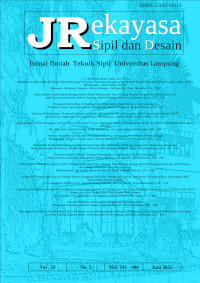Gap Acceptance Review Of Traffic Conflic In The Road Of Raden Ajeng Kartini.
DOI:
https://doi.org/10.23960/jrsdd.v9i1.1670Abstract Views: 132 File Views: 183 File Views: 0
Abstract
The behavior of drivers who do not consider the movements of other drivers can cause traffic problems, such as congestion and traffic accidents that can occur on the road. The stagger intersection at Jalan Raden Ajeng Kartini is often crowded with vehicles that can cause congestion. This is due to the behavior of drivers crossing from Cut Nyak Dien road to Lindu road, causing a conflict of delays influenced by weaving movements. The purpose of this research is to analyze the amount of delay due to weaving motion on the Raden Ajeng Kartini road.
This study uses an analysis of the gap acceptance approach, to get the big results of vehicle delays caused by weaving motion, the average gap time and critical gap.
The results of this study show that the vehicle delay caused by weaving motion is 3.20 seconds and 8.93 seconds in the morning and evening. The average gap time was 82.50 seconds in the morning and 94.36 seconds in the afternoon, while the critical gap was 4.34 seconds in the morning and 3.88 seconds in the afternoon.
Keywords: Gap Acceptance, Weaving, Delay.
Downloads
References
Gartner, Nathan H., Messer, Caroll., & Rathi, Ajay K. 2001. Traffic Flow Theory
State-of The-Art-Report Revised 2001. Rev.ed. Washington DC:
Committee on Traffic Flow Theory and Characteristics. Transportation
Research Board.
Khisty, Jotin C dan Lall, Kent B. 2003. Dasar-dasar Rekayasa Transportasi.
Edisi Ketiga. Jilid 1. Penerbit Erlangga: Bandung.
Pignataro, L.J. 1973. Traffic Engineering: Theory and Practice, Prantice Hall Int, Englewood Cliffs, N.J.
Downloads
Published
How to Cite
Issue
Section
License

JRSDD is licensed under a Creative Commons Attribution-NonCommercial 4.0 International License.

